Charge Group
WARNING: Do not cite this page as a reference. This page is on this wikispace only to make the content "searchable" and easier to find. If you find the information you seek here, go to the original sources as linked below to verify the information and use them for your documentation.
See also Slot Machine Heraldry (stub), Sword and Dagger Rule
From the Glossary of Terms:[edit | edit source]
A set of charges used together in a design as a single unit. The charges in groups in heraldry usually fall into standard arrangements depending on their number and what other items are involved in the design. A collection of charges that are arranged in such a standard arrangement are considered a single group, even if they are of different types and/or tinctures. For example, Per fess argent and gules, two towers sable and a roundel argent// contains a single group of primary charges in the standard charge arrangement of two and one. //See also Peripheral Charge Group, Primary Charge Group, Secondary Charge Group, Slot Machine Heraldry, and Tertiary Charge Group. http://heraldry.sca.org/coagloss.html
Charge Groups[edit | edit source]
http://heraldry.sca.org/laurel/lessons/lesson04.html
what is and is not a group[edit | edit source]
The definition given in the Glossary of the Rules for Submission is:
“A set of charges used together in a design as a single unit. The charges in groups in heraldry usually fall into standard arrangements depending on their number and what other items are involved in the design. A collection of charges that are arranged in such a standard arrangement are considered a single group, even if they are of different types.”
A key phrase is “standard arrangement”. What arrangements are standard? The rules do not provide explicit guidance; however, the following are standard arrangements:
- any arrangement of three objects
- four items in cross or saltire or three and one
- five items in cross or saltire
- charges on a charge or group of charges
(See also SENA)
Some examples:[edit | edit source]
| In Sable, three bezants, the three bezants are a charge group. | 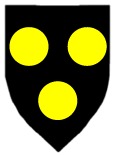
|
| In Sable, on a bend between two lozenges argent, four crosses crosslet gules, the two lozenges form a charge group and the four crosses crosslet form a charge group. | 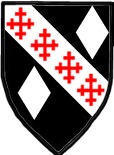
|
| In Gules, a cross between four crescents Or and on a chief argent a lymphad between two cinquefoils gules, the four crescents form one charge group, and the lymphad and the two cinquefoils together form a second charge group. | 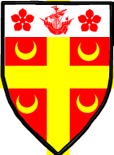
|
| In Per chevron gules and Or, two lions rampant and a fleam counterchanged, there is one charge group, being the two lions and the fleam. |
In the last two examples, there are charge groups that are not all the same charge. One herald, when shown something similar to the last example and asked how many charge groups there were, said “Two.” When told that it was a single charge group, she replied, “Why? What do they have to do with each other?” This brings up a point about period style. Period armory has coherence; a unity about the design. A charge group such as the two lions and the fleam does not present a coherent picture. It looks like it should be two independent groups. It is however, only one charge group. It is a group of three items in a standard arrangement. This is a hint that the design does not resemble the Middle Ages as much as we might like; however, that does not mean you should reject the design; it is registerable. If you can explain to the submitter how it could be improved, by all means do so, but if the submitter is intent on such a design, do accept it.
More examples:
| Consider Azure crusily argent, a chief Or. The semy of crosses crosslet (crusily) is a charge group. | 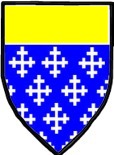
|
| In Per bend sinister sable and argent, a plate and a cinquefoil counterchanged, the plate and the cinquefoil form one charge group. This is very poor style but is registerable so long as the field division is not Per pale. If it was per pale it would be returned for breaking our rules on marshaled armory. | 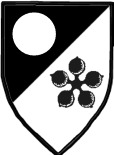
|
Primary, Secondary, Tertiary, Peripheral -[edit | edit source]
http://heraldry.sca.org/laurel/lessons/lesson03.html
|- |This lesson discusses the terms "primary", "secondary", "tertiary", and "peripheral" as applied to charges and charge groups in heraldry. |}
The glossary of the rules for submission defines the Primary Charge Group as the "The most important group of charges in a piece of armory. The primary charge group is usually mentioned first in the blazon. The primary charge is usually the central ordinary, if one is present. If there is no central ordinary, then the primary charge groups is the set of charges of the same size that are largest and visually dominate the center of the design."
For example, in Argent, a cross gules between four mullets sable, the cross is the primary charge.
In Per chevron argent and sable, two roses and a fleur-de-lys counterchanged, the primary charge group is the roses and the fleur-de-lys.
In Gules, a pale Or, overall a dragon argent, the primary charge is the pale, even though the dragon may well dominate the design.
In Or, a lozenge within a laurel wreath sable, the primary charge is the lozenge.
Returning to the glossary, a Secondary Charge Group is defined as "A group of charges placed on the field around the primary charge group." Note that you cannot have a secondary charge group without a primary charge group. In Argent, a cross gules between four mullets sable, the secondary charge group is the four mullets. In Gules, a pale Or, overall a dragon argent, the dragon is the secondary charge. In Or, a lozenge within a laurel wreath sable, the secondary charge is the laurel wreath. In Or, a maunche between three roundels azure, the secondary charge group is the three roundels. In Gules, a chevron between three daggers inverted Or and in base an oil lamp argent, there is one secondary group made up of the three daggers and the lamp. The charges are in a standard arrangement; thus they are treated as a single group.
Tertiary Charge Group "Any group of charges placed entirely on the other charges. Tertiary charges in a group may be together, such as three charges on a chief, or may each be on members of the same charge group." Per chevron argent and sable, two roses and a fleur-de-lys counterchanged and on a chief purpure three hearts argent, has one group of tertiary charges, the three hearts on the chief. In the design Or, on a fess gules a millrind between two escallops Or, all within a bordure vert charged with eight roundels argent", there are two tertiary charge groups, the millrind and the escallops and the roundels on the bordure.
Peripheral Charge Group "A charge or group of charges that are placed on the field near the edge of a piece of armory without affecting the rest of the design. Chiefs and bordures are the most common peripheral charges, but orles, tressures, or groups of separate charges used in the same area as a chief or bordure may also be peripheral charges."
For example, in Per chevron argent and sable, two roses and a fleur-de-lys counterchanged and on a chief purpure three hearts argent, the chief is a peripheral charge.
In Purpure, a cross between four eagles displayed argent within a laurel wreath Or, uses the laurel wreath as a peripheral charge.
Sometimes, the categories overlap, such as in Azure, a cross Moline and on a chief argent three lozenges azure//, where the chief is both a secondary and a peripheral charge. In //Gules, a chief argent, the chief is the primary charge as well as being a peripheral charge. Tertiary charges, however, are always nothing but tertiary charges. The other categories all lie at least partially on the field. Most blazons read Field, primary charge group, secondary charge group, peripheral charge group.
Tertiaries are mentioned after the secondary and/or the peripheral on which they appear. For example, in Argent, on a bend wavy between two eagles displayed sable, charged on the breast with a Latin cross, three escallops Or and a on a chief gules three Latin crosses Or, the primary charge is the bend, the secondary charge group is the two eagles, the peripheral charge is the chief, and each is charged with a tertiary group. By the way, this design is too complex, with four tinctures and five types of charges.
However, Vert, semy of mullets argent, three roundels erminois, the primary group is the three roundels, and the semy of mullets is a secondary group. Semys are secondary groups that get mentioned in the blazon before the primary group. {| | Some examples... |- |Argent, a cross gules between four mullets sable.//[[1]] //Primary__: the cross __Secondary : the group of four mullets |- |---- |- |Per chevron argent and sable, two roses and a fleur-de-lys counterchanged and on a chief purpure three hearts argent.//[[2]] //Primary//__ : the charge group containing the roses, and the fleur-de-lys__//Secondary//__ : the chief__//Peripheral//__ : the chief__//Tertiary : the charge group containing the three hearts |- |---- |- |Azure, a cross Moline and on a chief argent three lozenges azure.//[[3]] //Primary__// : the cross moline//__Secondary__// : the chief//__Peripheral__// : the chief//__Tertiary : the charge group containing the three lozenges |- |---- |- |Slot Machine Heraldry.The popular name given to the part of Rule for Submissions VIII.1.a., which states that "three or more types of charges should not be used in the same [charge] group." In Argent, in fess a cherry gules, a bell sable, and a lime vert//, there are three types of charges (cherry, bell, and lime) in the primary charge group; in //Argent, two lions combattant and a sword and axe crossed in saltire, there are also three types of charges (lion, sword, and axe) in the primary charge group. |- |http://heraldry.sca.org/coagloss.html |}
Sword and Dagger rule.The popular name given to rulings which disallow the use of similar but non-identical charges together on the field or in the same charge group. In Gules, a dragon and a wyvern combattant argent// the dragon and the wyvern are both on the field, and are similar but not identical; therefore this design violates the rule. Closely related are the rulings which disallow the use of the same charge in a primary and secondary group. In //Gules, a mullet and in chief three mullets Or//, both groups of mullets are on the field; therefore this design violates the rule. Conversely, in //Gules, a mullet and on a chief Or three mullets gules the rule is not violated, as the two groups of mullets are not both on the field.
http://heraldry.sca.org/coagloss.htm
Primary Charge Group.The most important group of charges in a piece of armory. In blazons, the primary charge group is usually mentioned immediately after the field (though a strewn charge group is not primary when it is blazoned before a central charge group). If there is a central ordinary lying entirely on the field, it is the primary charge. If there is no such central ordinary, then the primary charge group is the set of charges of the same size that lie in the center of the design and directly on the field. An overall charge can never be the primary charge. In any piece of armory with charges there will always be a primary charge group, unless the only charges are peripheral. There cannot be more than one primary charge group in any given design. In Gules, a pale between two mullets argent//, the pale is the primary charge. In //Or, a maunche between three roundels azure// the maunche is the primary charge. In //Per chevron argent and sable, two roses and a fleur-de-lys counterchanged and on a chief purpure three hearts argent//, the roses and fleur-de-lys are the primary charge group, because they are all of about the same size and in a standard arrangement. In //Azure semy of mullets and a chief argent// the strewn mullets are the primary charge group; in //Azure semy of mullets, an eagle and a chief argent// the eagle is the primary charge. In //Sable, a lion Or, overall a bend argent,// the lion is the primary charge. In //Azure, a chief Or// there is no primary charge group. //See also Overall Charge Group, Peripheral Charge Group, Secondary Charge Group, Semy, Tertiary Charge Group. http://heraldry.sca.org/coagloss.html
Secondary Charge Group.A group of charges on the field around the primary charge group. A design may have more than one secondary charge group. Each group may confer difference independently. In Gules, a pale between two mullets argent//, the mullets are the secondary charge group. The secondary charges in //Or, a maunche between three roundels azure// are the roundels. In //Sable, a chevron cotised argent between three millrinds Or// there are two secondary charge groups, the cotises and the millrinds. In //Per chevron argent and sable, two roses and a fleur-de-lys counterchanged and on a chief purpure three hearts argent//, the chief is the secondary charge group. A peripheral charge group is a type of secondary charge group. //See also Charge Group, Peripheral Charge Group, Primary Charge Group, Semy, Tertiary Charge Group. http://heraldry.sca.org/coagloss.html
Peripheral Charge Group.A charge or group of charges that are placed on the field near the edge of a piece of armory without affecting the rest of the design. Peripheral charges include (but are not limited to): the chief, the bordure, the base (including the point pointed), the quarter, the canton, the gyron, the orle, the double tressure, and flaunches. Gores and gussets are not// peripheral charges (because they extend so far into the center of the field). Peripheral charges are never primary charges, even if they are the only charges on the field. Peripheral Charge Groups are a type of secondary charge group. //See also Field Primary Armory, Ordinary, Primary Charge Group, Secondary Charge Group, Semy, Tertiary Charge Group. http://heraldry.sca.org/coagloss.html
Tertiary Charge Group.Any group of charges placed entirely on other charges. Tertiary charges in a group may be together, such as three charges on a chief, or may each be on members of the same charge group. Per chevron argent and sable, two roses and a fleur-de-lys counterchanged and on a chief purpure three hearts argent// has one group of tertiary charges on the chief. //Gules, a chevron between three roses Or, each charged with a cross fitchy sable// has one group of tertiary charges, the crosses. //Or, on a fess gules an escallop between two millrinds Or, all within a bordure vert charged with eight roundels argent// has two groups of tertiary charges, one group with the escallop and millrinds and the other with the roundels. Each tertiary group contributes to difference independently. //See also Peripheral Charge Group, Primary Charge Group, Semy.
Overall Charge.A charge that crosses over both edges of another charge to lie on the field on either side. For instance, Or, a lion rampant purpure and overall a fess sable has the fess starting on the field on one side, crossing over the center of the lion, and lying on the field on the other side. An overall charge is considered to lie directly on the field, and must have good contrast with it. An overall charge can never be the primary charge; in addition, there can only be a single group of overall charges.[http://heraldry.sca.org/coagloss.html
Precedents:[edit | edit source]
Precedents of the SCA College of Arms - http://heraldry.sca.org/laurel/precedents.html
Morsulus Heralds Website - http://www.morsulus.org/ (to search the LoARs and Precedents)
Use the above links to be sure any precedents listed below haven't been superseded by newer precedents.
February 2019 - 3 different types of charge in a group "slot machine"[edit | edit source]
Gabrielle van Nijenrode. Augmentation of arms. Gules, a fess bretessed between three gouts and an amphora Or, for augmentation issuant from base a demi-escarbuncle argent. This device is returned for violation of SENA A3D2a, the "slot machine" rule, which prohibits more than two different types of charge in any charge group. In the July 2004 return of the augmentation of arms for the Barony of Ildhafn, it was ruled, "While the addition of augmentations can be allowed to break rules in some cases, the violations we allow are grounded in period examples. Barring examples of period augmentations that result in three types of charges in the same group, this sort of augmentation cannot violate RfS VIII.1.a." This ruling was upheld in the September 2009 return of the augmentation of the Shire of Riviere Constelle. In this submission, there are three types of charge in the secondary charge group: gouttes, amphora, and demi-escarbuncle. It must therefore be returned. http://heraldry.sca.org/loar/2019/02/19-02lar.html#18
January 2019 - two similar charges in a group "sword and dagger"[edit | edit source]
Einrich Stein Hogger. Device. Argent, a natural sea-tortoise vert charged with a tree blasted and eradicated Or and maintaining an axe and a tomahawk sable. "This device is returned for violation of SENA A3D1, the "sword and dagger" rule, which disallows the use of visually similar but blazonably different charges. Submitted as maintaining an axe and a hammer sable, the sinister charge does not appear to be any documented hammer, and more resembles a tomahawk than anything else. A tomahawk is a type of axe, and is therefore blazonably different but visually similar to the other maintained axe in the artwork." http://heraldry.sca.org/loar/2019/01/19-01lar.html#13
November 2018 - 3 different tinctures in a group[edit | edit source]
Madelina Katerina Cadwyn. Name and device. Per chevron Or and azure, a crescent purpure, a crescent gules, and a tyger rampant Or. There is a step from period practice for charges of three different tinctures in the same charge group. http://heraldry.sca.org/loar/2018/11/18-11lar.html#40
November 2012 CL - Charge Groups Doing the Splits[edit | edit source]
Now that we've covered the posture/orientation of individual charges in a group, we turn to their placement upon the field. SENA A3D2c only peripherally covers this topic when it references SENA Appendix K, which lists some standard arrangements. However, Appendix K is primarily intended for determining if a DC for change of arrangement exists when comparing two groups from two pieces of armory. It does not list all of the possible standard period arrangements for charges in a single group on the field.
When considering a group of charges split over a divided field or separated by a central ordinary, period armory typically draws and places such charges in whatever way allows them to best fit and take up the most space possible. Examples:
- * BSB Cod.icon.291, f. 13r: _Argent, on a bend sable between three wolf's heads gules three birds argent_. The two wolf heads in the upper portion of the field are in fess.
- * BSB Cod.icon.291, f. 24r: _Gules, a bend between six cross crosslets fitchy argent_. The three crosses in the upper portion of the field are placed two-and-one, and the three crosses in the lower portion of the field are in bend.
- * Beinecke MS 648, f. 38v: _Or, a bend between six martlets gules, a label azure_. The three martlets in the upper portion of the field are placed "in right triangle" to follow the edge of the shield, with one firmly in the corner, one to the left, and one below. The three martlets in the lower portion of the field are in bend.
- * The Luttrell Psalter, f. 202v, has an illumination showing six different depictions of the same arms. Sir Geoffrey Luttrell's arms were "Azure, a bend between six martlets argent". His arms are shown on a heater shield, like our device form escutcheon, on his ailettes, a square shape like our badge form, a triangular pennant, his saddle, his horse barding, his crest, his surcoat, and on two dresses. The martlets on either side of the bend are arranged in all combinations of two-and-one, "in right triangle", in bend, in pale, and "in swoop" where the birds are mostly in bend with the centermost moved out of line a bit.
Therefore, charges in a single group split in two by a field division or a central ordinary that are placed to reasonably fill the space available to them and that are similar to period patterns will be considered to be in a default arrangement, and they do not require their exact positioning to be blazoned. This is similar to our policy of allowing and not distinguishing various period-style arrangements of strewn charges, and in general not blazoning period-style artistic variations. Note that this applies only to arrangement, not to posture or orientation.
Many thanks to Yehuda ben Moshe for bringing many of these examples to light in a short timeframe, and to Daniel de Lincoln for pointing out the excellent Luttrell Psalter example. Sources cited:
- BSB Cod.icon.291, Insignia Anglica, English, 16th C (@http://daten.digitale-sammlungen.de/bsb00001647/image_1)
- BnF fr.4985, Armorial de Gilles le Bouvier, French, 15th C (@http://gallica.bnf.fr/ark:/12148/btv1b85285803)
- Beinecke MS 648, Jean Faucket's Commonplace Book, Burgundian, 15th C (@http://beinecke.library.yale.edu/dl_crosscollex/getSETS.asp?ITEM=2027590)
- SGS Cod.Sang.1084, St. Gall Abbot Ulrich R{o:}sch's armorial, Swiss/German, 15th C (@http://www.e-codices.unifr.ch/en/list/one/csg/1084)
- Siebmacher, German, 16th C (@http://www.wappenbuch.de/)
- BSB Cod.icon 307, German, c1600 (@http://daten.digitale-sammlungen.de/bsb00020245/image_1)
- Luttrell Psalter, English, 14th C (@http://www.bl.uk/onlinegallery/ttp/luttrell/accessible/pages27and28.html)
http://heraldry.sca.org/loar/2012/11/12-11cl.html
August 2001 - mixed tinctures and types on a chief[edit | edit source]
Liuete Liana da Luna. Name and device. Per pale azure and purpure, a cross of Calatrava and on a chief argent a decrescent azure between two mullets purpure.
It may interest the College to know that examples of a chief charged with a group of charges of dissimilar tincture and type are known from the Tudor period in England. Thomas (Cardinal) Wolsey's arms were Sable on a cross engrailed argent a lion passant guardant gules between three (lion's) faces (azure or sable?) on a chief Or a rose gules between two cocks sable (per p. 80 of Gwynn-Jones and Bedingfield's Heraldry). Another example of a chief using a tertiary group with mixed types and tinctures is on p. 96 of the same book, from Wriothesley's tenure as Garter Principal King of Arms. Designs where a chief or other ordinary was charged with two different types of tertiary (an A between two Bs all in the same tincture) are rather common in Wriothesley's designs. https://heraldry.sca.org/loar/2001/08/01-08lar.html
Collected Precedents:[edit | edit source]
Tenure of Elisabeth de Rossignol (May 2005 - July 2008) - CHARGE GROUP The 2nd Tenure of François la Flamme (October 2004 - May 2005) - [GROUP] The Tenure of Shauna of Carrick Point (May 2004 - August 2004) - The Tenure of François la Flamme (August 2001 - April 2004) - The Tenure of Elsbeth Anne Roth (June 1999 - July 2001) - The Tenure of Jaelle of Armida (June 1996 - June 1999) - The 2nd Tenure of Da'ud ibn Auda (November 1993 - June 1996) - The Tenure of Bruce Draconarius of Mistholme (June 1992 - October 1993) - The 1st Tenure of Da'ud ibn Auda (June 1990 - June 1992) - The Tenure of Alisoun MacCoul of Elphane (September 1986 - June 1990) - The Tenure of Baldwin of Erebor (August 1984 - August 1986) - The Tenure of Wilhelm von Schlüssel (August 1979 - August 1984) - The Tenure of Karina of the Far West (December 1975 - June 1979) - The Early Days (June 1971 - June 1975) -